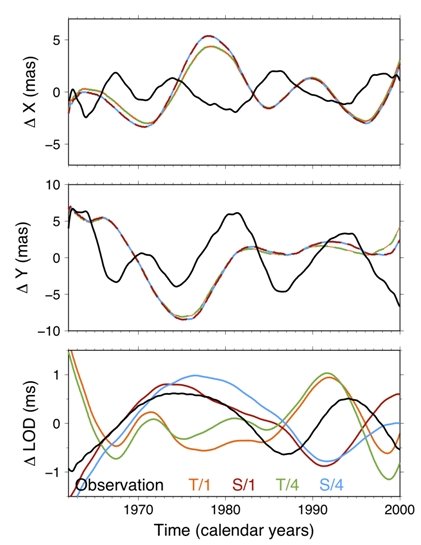Mass motions in the Earth’s core and mantle and their influence on polar motion
FOR 584 - Project 4
Duration: 1.3.2009 - 29.2.2012
The main part of the decadal variations in the Earth's rotation parameters (ERP) could not be explained by surface processes like atmospheric and oceanic excitation. Therefore, processes in the Earth's interior must cause most of the variations in the ERP over decadal time scales. Such processes include the core-mantle coupling, gravitational coupling between the inner core and the mantle and coupled oscillations of these sub-systems (inner core, outer core, mantle), which are subject to this project.
For the theoretical description of the influence of such internal processes on the Earth's rotation two different approaches exist. Either the conservation of angular momentum in a combined system is considered or the acting coupling torques between individual sub-systems are determind, like elektromagnetic or topographic coupling torques between the fluid outer core and the mantle. We developed a theoretical description for the electromagnetic (EM) and the topographic (TOP) coupling torques, which act on the mantle at the core-mantle-boundary (CMB). For further details, we refer to the topic "Core Mantle Dynamics".
Here, we give an example for an application of this theory, which is extended to a joint-coupling model for the EM and TOP coupling torques. Based on the newly developed geomagnetic field model C3FM2 and a set of additional input models, like the electric conductivity of the Earth's mantle and the topography of the CMB, we compute EM and TOP core-mantle coupling torques jointly. The combined coupling torque is expressed by equivalent excitation functions, which can be considered together with excitation functions of surface processes in the Euler-Liouville equations.

This investigation is restricted to this time interval 1962-2000, because the considered atmospheric (AAM) and oceanic angular momentum (OAM) functions are based on the ERA-40 reanalysis provided by the ECMWF and which is made for this time interval. We use a combination of the equivalent excitation functions, AAM and OAM time series and further information, for the forward calculation of the variation of polar motion and length-of-day (LOD) on decadal time scale. In Figure 1 results for different input model combination are compared with the observed decadal variation of ERP (IERS C04 time series).
For all components, the modelled and observed decadal variation of EOP have the same order of magnitude. For the input model combination S/1 and S/4, the ∆LOD shows similar variation in time as the observed one. In contrast, the polar motion show no significant correlation in time with the observations. The further work in the project is focused on the problem to explain these significant differences, which are related to not yet considered internal processes like the gravitational coupling of the inner core with the mantle.

